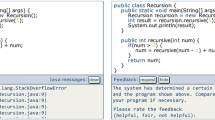Abstract
The main components of an Intelligent Computer-Assisted Instruction (ICAI) system are the expertise, the student model and tutoring strategies. The student model manages what the student dose and dose not understand, and the performance of an ICAI system depends largely on how well the student model approximates the human student. We propose a new framework for ICAI systems which uses the inductive inference for constructing the student model from the student’s behavior. In the framework, both the expertise and the student model are represented as Prolog programs, which enables to express the meta-knowledge that is the knowledge of how to use the knowledge. Since the construction of the student models is performed independently of the expertise, the framework is domain-independent. Therefore, an ICAI system for any subject area can be built with the framework. As an example, the ICAI system teaching chemical reaction is presented together with a sample performance. The authors believe that the new framework for ICAI systems based on logic programming and inductive inference could be a breakthrough of the future ICAI systems.
Similar content being viewed by others
Explore related subjects
Discover the latest articles, news and stories from top researchers in related subjects.References
Carbonell, J. R., “AI in CAI: An Artificial Intelligence Approach to Computer-Aided Instruction,”IEEE Trans. Man-Mach. Syst., Vol. MMS-11, No. 4, pp. 190–202, 1970.
Barr, A. and Feigenbaum, E. A.,The Handbook of Artificial Intelligence, Vol. II, PITMAN, London, pp. 225–235, 1983.
Clocksin, W. F. and Mellish, C. S.,Programming in Prolog, Springer-Verlag, New York, 1981.
Angluin, D. and Smith, C. H., “Inductive Inference: Theory and Methods,”ACM Comput. Surv., Vol. 15, No. 3, pp. 237–269, 1983.
Clancey, W. J., “Tutoring Rules for Guiding a Case Method Dialogue,” inIntelligent Tutoring Systems (Sleeman, D. et al. ed.), Academic Press, London, pp. 201–225, 1982.
Brown, J. S. and Burton, R. R., “Diagnostic Models for Procedural Bugs in Basic Mathematical Skills,”Cognitive Science, 2, pp. 155–192, 1978.
Shapiro, E. Y.,Algorithmic Program Debugging, MIT Press, London, 1982.
Sleeman, D. and Hendley, R. J., “ACE: A System Which Analyses Complex Explanations,” inIntelligent Tutoring Systems (Sleeman, D. et al. ed.), Academic Press, London, pp. 99–118, 1982.
Ganke, M. et al., “An ICAI System for Prolog Programming Based on Inductive Inference,”Proc. of 28th National Conference of Information Processing Society of Japan, 1G-1, Tokyo, [in Japanese], 1984.
Author information
Authors and Affiliations
About this article
Cite this article
Kawai, K., Mizoguchi, R., Kakusho, O. et al. A framework for ICAI systems based on inductive inference and logic programming. New Gener Comput 5, 115–129 (1987). https://doi.org/10.1007/BF03037461
Received:
Issue Date:
DOI: https://doi.org/10.1007/BF03037461




